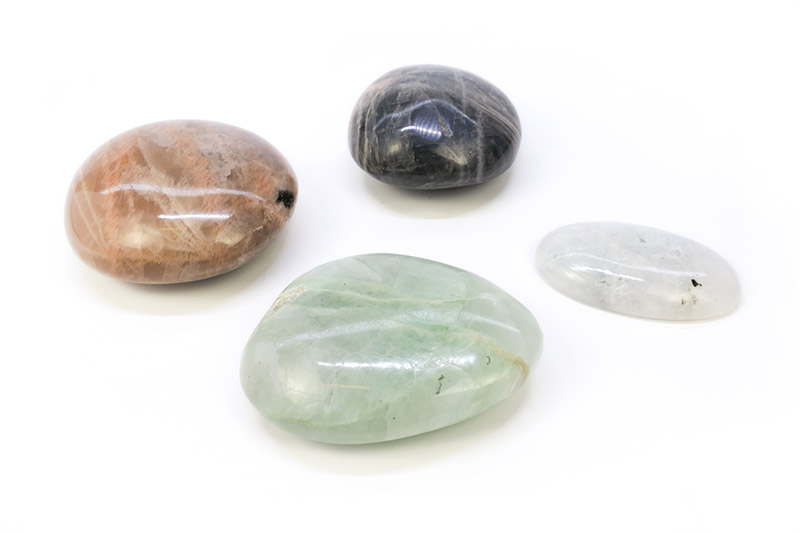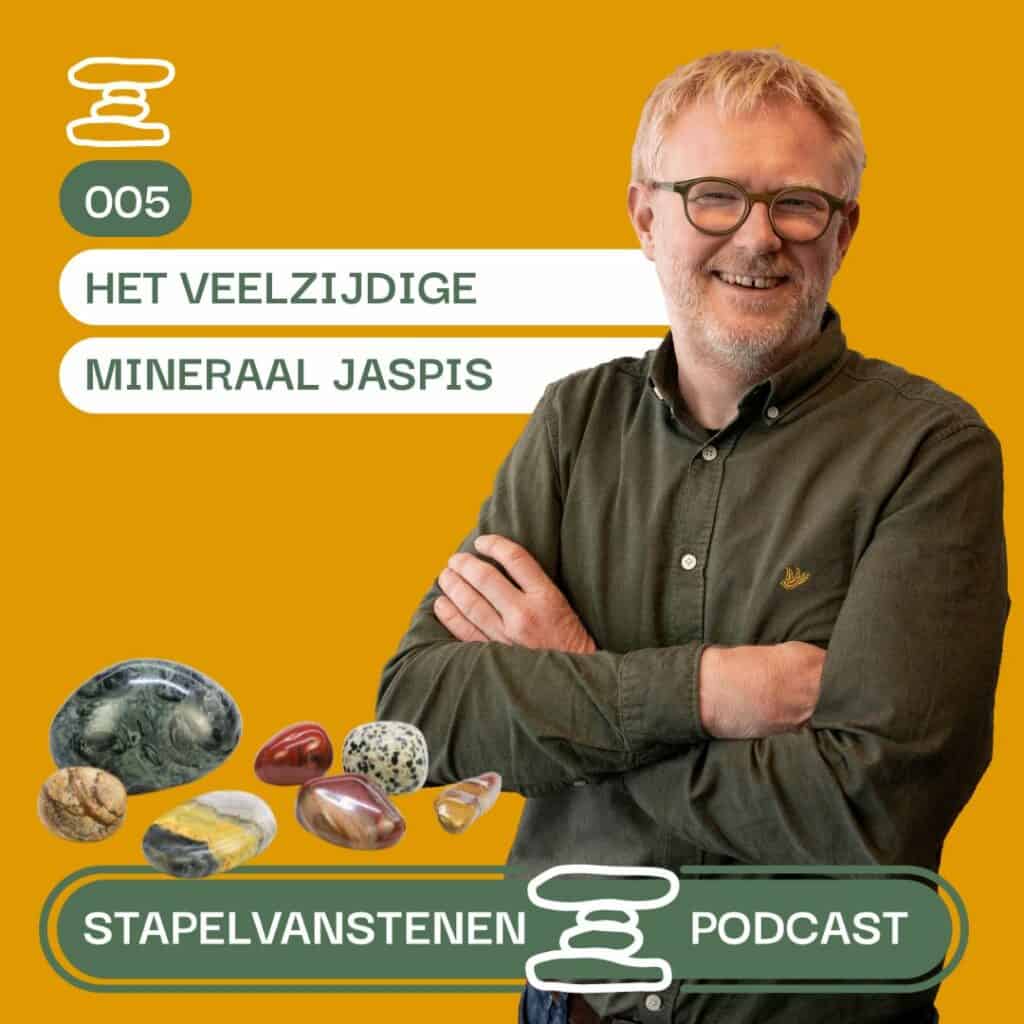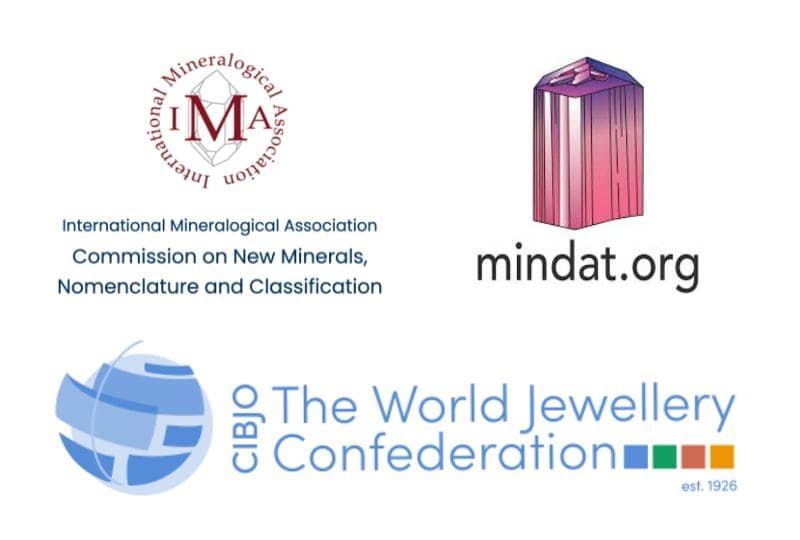Analysis: Rainbow moonstone

Genuine moonstone or white labradorite?
At the bottom of the page you find a summary of the main points of this analysis.
Rainbow moonstone is perhaps the most popular “moonstone” on the market. In addition to cut stones in jewelry, we also see many cut spheres, obelisks and tumble stones, mainly from India or Sri Lanka. Basically, it is a white glassy stone with a mainly multi-colored (rainbow) flash, hence the name. There is frequent discussion among enthusiasts and sellers whether this is actually “white labradorite” or “true moonstone. To clarify this, a number of specimens have been analyzed. A detailed explanation of the results and background can be found in this article, a summary of the main points can be found at the bottom.

What is moonstone?
Moonstone is not an official mineral name, but a trade name for white feldspar with a blue flash. Mineralogically, most cases involve orthoclase combined with albite, two minerals in the feldspar group. But there are also other feldspars that can show a blue flash, for example peristerite (a variety of albite), antiperthite and anorthoclase. All of these minerals with a blue flash are often grouped together under the term moonstone for convenience.
Nowadays, however, the name ‘moonstone’ has become more a reference to the optical effect, a form of ‘flash‘ in various feldspars, than a name for the specific minerals mentioned above. Therefore, with the increasing popularity of moonstone, the name is being used for all kinds and colors of feldspar that sometimes do not show any form of blue ‘flash’ at all, so in my opinion they do not really deserve the name moonstone. Thus we now know black, gray, pink, peach, white, beige, green and rainbow moonstone. The exact mineralogical composition of these types is often not known, but is probably of no interest to most enthusiasts and sellers either. Enthusiasts want “moonstone” for its attractive appearance, but especially for the (spiritual) properties attributed to it. Moonstone is booming business.
Moonstone from a gemological perspective
In gemology and the international gemstone trade (and I do not mean the trade in tumbled stones and ornaments but in cut faceted stones or cabochons for jewelry), a white translucent to transparent orthoclase feldspar with predominantly blue flash is still considered the classic “real” or “normal” moonstone. In this regard, the brighter the moonstone and the bluer the flash, the more precious the stone. Prices for good moonstone can be as high as $100 per carat. Of course, inclusions, size of the stone and quality of cutting also play a role in the price.
When multiple (rainbow) colors are present, the gemstone trade also speaks of rainbow moonstone. It is said by some sellers and gemologists that this is actually white labradorite. This is not surprising, as the American gemstone institute GIA also describes rainbow moonstone as a form of labradorite (GIA, 2024). The GIA even states that the actual identity of a mineral is not so important to be called moonstone, but rather the beauty of its (blue) flash. From a mineralogical point of view, there is a different opinion. Stones of rainbow moonstone are sometimes considerably cheaper than the “real” moonstone. The name moonstone is more popular and probably also brings in more money than when it is called (white) labradorite. The designation rainbow moonstone now seems to have been adopted throughout the trade for all white feldspar with blue- or rainbow-colored flash, and sometimes the same stone is thus referred to as white labradorite.
Rainbow moonstone: ‘genuine’ moonstone or white labradorite?
To properly answer that question, however, I must first explain something about how the large group of feldspars, which moonstone and labradorite both fall under, is classified. Indeed, the minerals in the feldspar group are divided based on their chemical composition into two series with three possible end members; a potassium feldspar such as orthoclase or microcline (KAlSi3O8), a sodium feldspar albite (NaAlSi3O8) and a calcium feldspar anorthite (CaAl2Si2O8). The minerals between the potassium feldspar and albite are called the alkali feldspars and between albite and anorthite are called the plagioclase feldspars. Classic “true” moonstone is mineralogically a combination of orthoclase or microcline with albite and belongs to the group of alkali feldspars. Labradorite is a combination of albite and anorthite (ratio of albite:anorthite from 30:70 to 50:50) and belongs to the group of plagioclase feldspars. More information and examples of minerals from the feldspar group can be found in my video on feldspar on my YouTube channel.
Thus, genuine orthoclase-albite moonstone and white labradorite are two different minerals, each with its own characteristics, but both are offered under the trade name rainbow moonstone.

Phase diagram feldspar group with the alkali feldspars on the left and the plagioclase feldspars below (Muskid – Own work, CC BY-SA 4.0, https://commons.wikimedia.org/w/index.php?curid=46491727)
So how can you tell which type of rainbow moonstone you have?
So both orthoclase-albite moonstone and white labradorite (albite-anorthite) can look similar in color and flash and also have some of the same properties. For example, both have a hardness of 6-6½ and a density close to each other (2.56-2.59 and 2.65-2.75). Optically, with the white labradorite (albite-anorthite) you might see more rainbow colors than blue in the flash and with a magnifying glass or microscope you might observe the typical plagioclase striation, but that gives no guarantees.
To make definitive distinctions, analysis can be done in a lab to determine chemical composition and crystal structure (EDX, Raman, XRD). In addition, a gemologist can distinguish using a refractometer, as the two have a different refractive index (RI). Orthoclase-albite moonstone has an RI between 1.518-1.527 and labradorite between 1.554-1.573.
What causes the flash in moonstone?
The flash or pearl effect for which the moonstone is so well known is seen when striking light is refracted by the alternating layers of orthoclase/microcline and albite created by exsolution during cooling. This effect is also called Schiller effect or adularescence, named after adularia (a variety of orthoclase or microcline) in which the optical effect was first described. In labradorite, a similar effect occurs due to a kind of lamellae of albite and anorthite that provide the rainbow colors or labradorescence. These parallel layers or lamellae is a typical feature of plagioclase feldspars and this is seen as a kind of striation in the stone.

Analysis of different (rainbow) moonstones
So it turns out that rainbow moonstone can be different minerals within the feldspar group based on a number of properties. Since this is hardly distinguishable with the naked eye without further examination, I have studied a number of samples of moonstone from Sri Lanka and India in more detail and had them analyzed in a lab.
Moonstone from Sri Lanka
Spencer published as early as 1930 about moonstone from Sri Lanka that it consisted of a mixture of orthoclase and albite. In a publication by Iamsupa, Srithai & Boomsoong (2016), their analysis of moonstone from Sri Lanka (Ceylon moonstone) also shows that it is chemically orthoclase with albite, “real” moonstone in other words. They measured a refractive index of 1.515-1.525, also fitting true moonstone.
The rough moonstone from Matiyagoda, Galle District, Sri Lanka that I studied shows a distinct bluish pearl luster with no other (rainbow) colors. Cleavage surfaces are visible but no plagioclase striation. Based on these characteristics and the analyses of previously studied Sri Lankan moonstone, this is most likely the true orthoclase-albite moonstone (not yet confirmed by lab analysis).


Left rough piece (5 cm wide) of white feldspar with blue pearl flash (Sri Lanka).
Right: detail image via USB microscope of blue adularescence, no plagioclase striation visible.
The two cut cabochons of moonstone from Sri Lanka are almost completely transparent with a distinct pearl luster, only the oval cabochon shows a slight blue adularescence in striking light. In both, a refractive index of 1.52-1.53 was measured, at the upper end of the refractive index of orthoclase-albite (1.518-1.527), but clearly lower than that of labradorite (1.554-1.573). Under the microscope, no obvious plagioclase striation was observed. In the photos with the USB microscope, some striations are visible, but they are curved and embedded in the surface of the stone (grinding marks). In both cabochons, a slight blue adularescence is also visible under the microscope.




Moonstone cabochon cut stones (Sri Lanka). (3.35 ct and 5.20 ct)
Left: mainly pearl luster with slight blue flash and no striation visible. The visible lines in the bottom photo via USB microscope are not plagioclase striation but grinding marks on the surface.
Right: clear cream-colored pearl lustre and only in the detail image via USB microscope (below) a slight blue adularescence is visible, no plagioclase striation observed.
(Rainbow) moonstone from India
The first sample of Indian moonstone I had analyzed was a rough piece sold as rainbow moonstone. Externally visible a white glassy feldspar with partially present striation typical of plagioclase feldspars and blue flash here and there. Analysis using EDX/EDS, Raman spectroscopy and X-ray diffraction (XRD) confirm the presence of albite and anorthite, the two feldspar end members of the plagioclase series. Thus, this could be called white labradorite.



Left rough piece (6 cm wide) of white glassy feldspar with mostly blue flash here and there.
Middle and right: detail image via USB microscope of blue adularescence and clearly present plagioclase striation.
The typical plagioclase striation was also found when studying tumble stones of Indian rainbow moonstone. As well as in a second rough piece of rainbow-colored moonstone from India. The black mineral is often referred to by sellers as tourmaline, but it has been identified as biotite.


Left: polished and broken tumbled stones of rainbow moonstone with limited flash or rainbow colors.
Right: detail image via USB microscope of rainbow-colored flash and clearly present plagioclase striation. The black mineral is biotite.


Left: rough piece of rainbow moonstone, 3cm wide on console (Tamil Nadu, India), with distinct rainbow colors.
Right: detail image via USB microscope of rainbow-colored flash and clearly present plagioclase striation.
Further examination of three cabochons and a faceted moonstone from India revealed that two of the four moonstones show a refractive index of 1.51-1.52, matching “true” orthoclase-albite moonstone. These also have mainly blue adularescence. The other two have more rainbow colors, plagioclase striations and a refractive index of 1.55-1.56, appropriate for a plagioclase feldspar such as labradorite.




Moonstone faceted and cabochon cut stones (India). (4.45 ct and 2.20 ct ), only blue flash and no striation visible. An RI of 1.51-1.52 was measured. Below: detail images via USB microscope.




Rainbow moonstone cabochons (India). (Left 4 x 2.3 cm, right 1.75 ct) with rainbow-colored flash and striation. An RI of 1.55-1.56 was measured. Below: detail images via USB microscope.
Conclusion
The (rainbow) moonstones from Sri Lanka that have been studied show the characteristics of “true” orthoclase-albite moonstone. This is consistent with previous research results of moonstones from Sri Lanka. The designation white labradorite is not appropriate for these stones.
Most rainbow moonstones from India that have been examined appear to be mineralogically albite-anorthite and belong to the plagioclase series to which labradorite also belongs. They exhibit rainbow colors and typical plagioclase striation. A refractive index appropriate to labradorite was also measured in two of the four cut stones. So this rainbow moonstone could possibly also be called white labradorite Two other cut stones from India with a refractive index appropriate to orthoclase-albite moonstone also show predominantly blue adularescence and no plagioclase striation is visible. For these latter stones, the designation white labradorite is not appropriate.
So, based on appearance or origin (India or Sri Lanka) it is not easy to say that rainbow moonstone is always white labradorite. If you see clear striation with a magnifying glass or microscope then you are at least dealing with a plagioclase feldspar and could call it white labradorite. Further distinction can only be made with further analysis using a refractometer or analysis in a lab.
Key points from this article:
- Rainbow moonstone is a commercial name for white feldspar with a form of blue or multi-colored “flash” or pearlescent luster.
- Mineralogically, rainbow moonstone can be “true” orthoclase-albite moonstone (from the group of alkali feldspars) or albite-anorthite (from the group of plagioclase feldspars, which also includes labradorite). These types can hardly be distinguished from each other with the naked eye and without further examination.
- The pure separation of the different types of rainbow moonstone is probably of no interest to the general public, nor is it practical for most enthusiasts or sellers. But it cannot be said simply on the basis of appearance or origin (India or Sri Lanka) that rainbow moonstone is always white labradorite.
- It is advisable to use the designation “white labradorite” only if the stone has clear characteristics such as plagioclase striation under the magnifying glass or microscope and/or when further examination (refractive index of labradorite or chemical composition in a lab) reveals that it is labradorite (albite-anorthite).
- The black mineral regularly found in rainbow moonstone from India has been identified as biotite and thus is not black tourmaline as is often indicated.
Thank you to Sven Huigen of Facets by Sven for providing some cabochons.
This post was published on social media and the previous Stack of Stones website on Nov. 30, 2021. A summary of it was included in the May 2022 book “Belazeriet of niet? The article was expanded and updated on Feb. 23, 2024. It will also be available through the online “Gem or Scam?” libraryas of September 2025.
References
Iamsupa, N., Srithai, B. & Boonsoong, A. (2016). Gemological Characteristics of Moonstone from Sri Lanka. Conference paper: The 5th International Gem & Jewelry Conference (GIT 2016) At: Pattaya, Thailand.
GIA (2024). Gem encyclopedia, Moonstone. Retrieved from: https://www.gia.edu/moonstone
Gemdat (2024). Labradorite. Retrieved from: https://www.gemdat.org/gem-2308.html
Gemdat (2024). Moonstone. Retrieved from: https://www.gemdat.org/gem-2774.html
Spencer, E. (1930). A Contribution to the Study of Moonstone from Ceylon and Other Areas and of the Stability-Relations of the Alkali-Felspars.






Responses